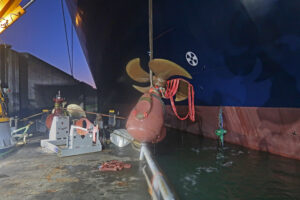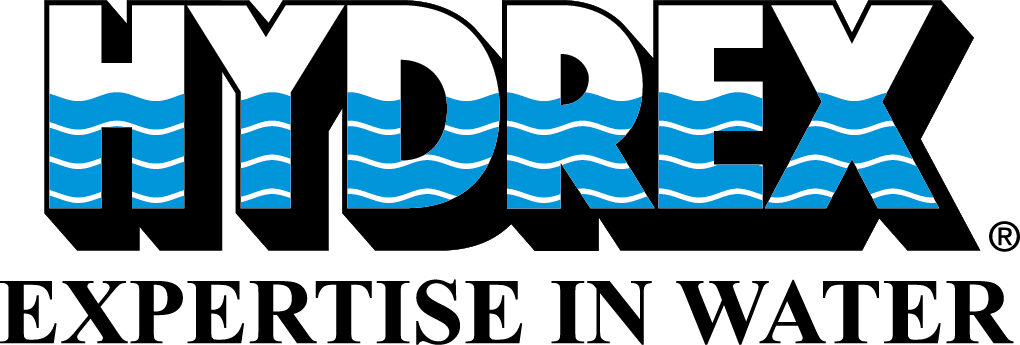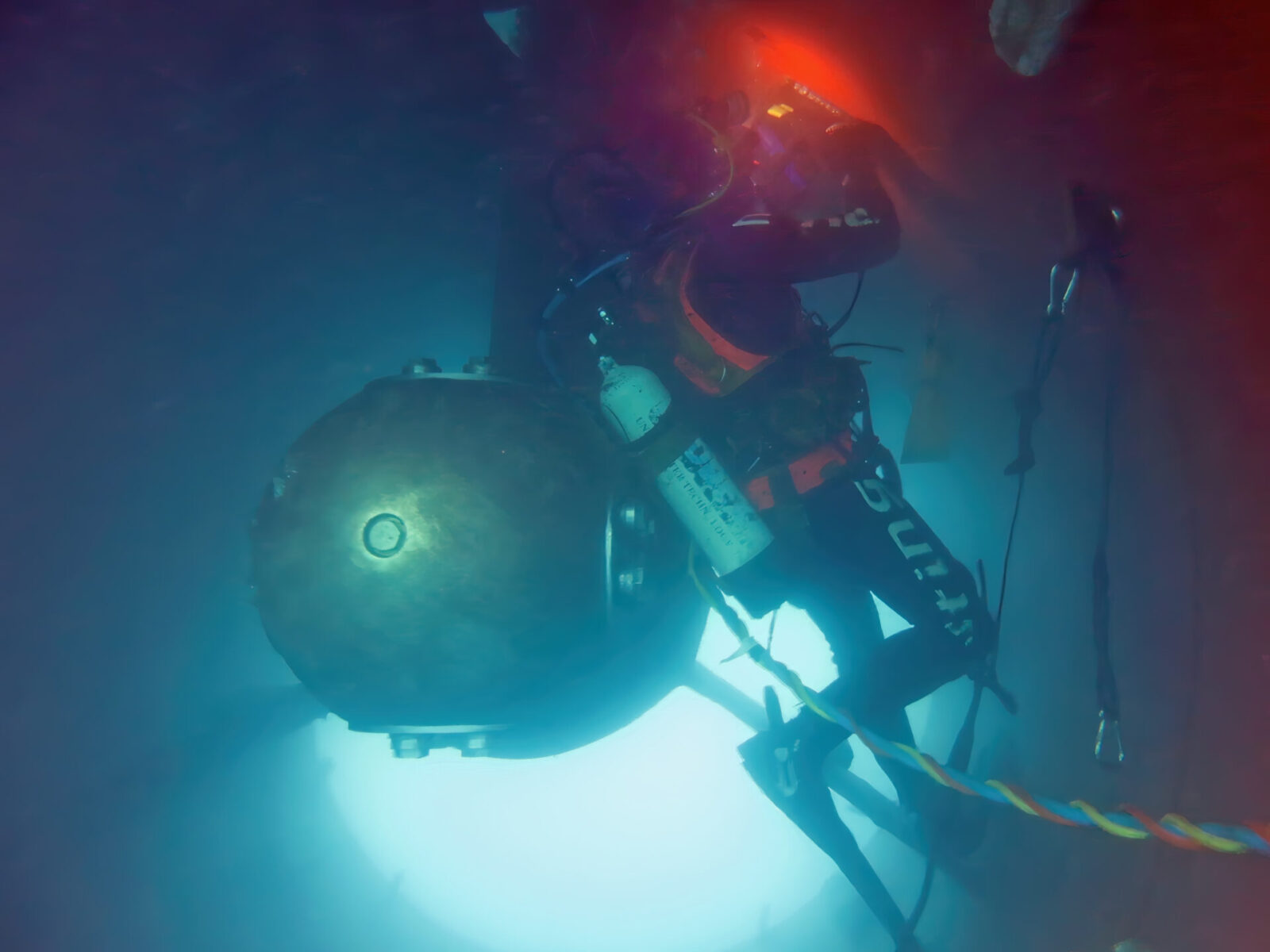For Hydrex’s 50th anniversary we are looking back at the history and a few memorable case studies of each of the services we offer to our customers. This month we are focusing on underwater thruster repairs.
We can perform a wide range of repair or maintenance work on all types of thrusters. An entire unit can be overhauled, propeller blades and seals can be replaced or repair work on another specific part of a thruster can be performed on-site or inside the tunnel. These repairs are performed in cooperation with OEMs. They can be carried out with the vessel afloat with minimum impact on its schedule.
Tunnel thruster operations specifically are carried out using our flexible mobdocks that close off the tunnel on both sides. This allows divers to work in a dry environment around the unit. Our range of flexible mobdocks can quickly be transported to any location.
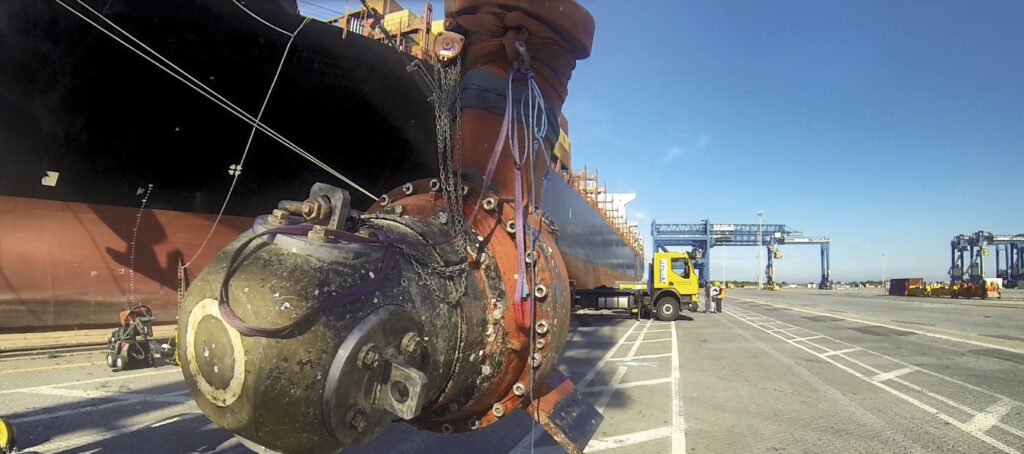
The size of the thruster does not matter. Hydrex flexible mobdocks can easily be adapted to the circumstance. They can be used for a wide range of repair or maintenance work on all types and sizes of thrusters and vessels.
In most cases a thruster overhaul is planned in during a scheduled drydocking. This usually means that the unit is removed in drydock and taken to the repair shop. The ship then has to wait for the overhauled thruster to be returned and reinstalled before the vessel can leave drydock. This results in a longer drydock time and consequent extra costs. Our teams can, however, remove the unit before the ship enters drydock so it that can be brought to the manufacturer for overhaul ahead of time. When the vessel enters drydock the overhauled unit is ready for reinstallation without any delay.
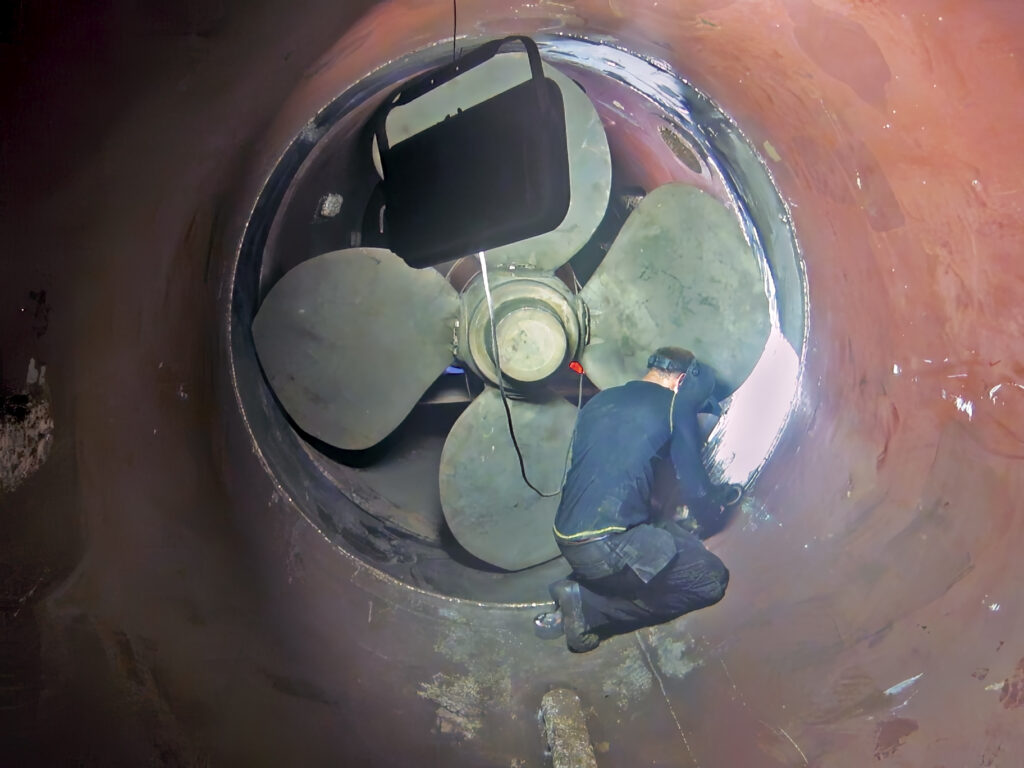
The reverse procedure is also possible. If the thruster is removed in drydock, we can reinstall it underwater in dry conditions at a later date after it has been overhauled. In this way the ship can leave drydock while the unit is still with the manufacturer.
Bow thruster replacement keeps cruise vessel on schedule
A bow thruster failure can have profound consequences not only for navigational safety but also the shipowner’s operational expenditure, especially if tugboats are required to berth the vessel. But when the vessel is a cruiseship facing disruption to schedules, then the consequences can be even more severe, denting both the balance sheet and the corporate reputation.
The owner of a 208-meter cruise ship sailing off the Caribbean was faced with such a dilemma when one of the vessel’s two bow thrusters malfunctioned. A solution was needed that could be carried out on-site without interrupting the vessel’s schedule.

Enter our tried and tested underwater repair facility mobdock.
The repair was straightforward, but an eight-hour window in various locations added an altogether different dimension, as Dave Bleyenberg, Tech Services at Hydrex, recounts; “The repair itself was one our teams had done on many occasions, but the ship’s timetable was the tricky part. Its cruise itinerary included several short port-stays so we had to devise an effective repair plan that would allow us to the carry out the thruster replacement in eight-hour stages, across several different ports. It was a logistical challenge.”
The moment the cruise ship berthed in one port, our divers set about removing the bow thruster unit and blades in the wet, ensuring everything was watertight before the vessel made way to her next port of call, where the new bow thruster would be installed.
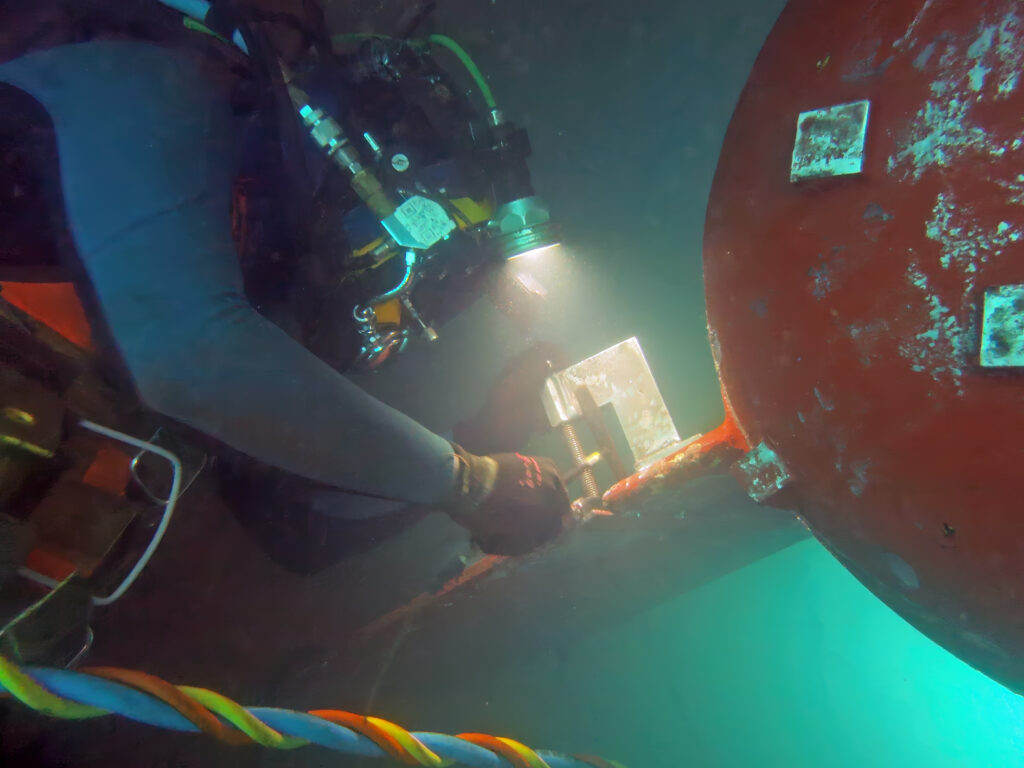
“By the time the vessel had arrived at the second port, our mobdock team had also arrived and swiftly got to work erecting the flexible habitat in-situ, closing off the thruster tunnel. This part of the repair can only be carried out in a clean, dry environment to avoid water ingress to the new thruster unit,” says Bleyenberg.
The in-house designed mobdock technology differs from other rigid underwater habitats, providing a more lightweight, flexible structure that can be rapidly deployed and erected. We have been using the technology to expedite a wide range of underwater repair or maintenance work for well over twenty years.

“The mobdock and our underwater repair know-how saves shipowners considerable time and money,” says Bleyenberg. “I can’t imagine the financial losses that would be incurred should a vessel have to cancel its itinerary, but we completed that job across multiple sites in just eight hours…and the passengers were none the wiser.”
Underwater removal and reinstallation of 60-ton azimuth thruster in Cartagena
In 2010 we mobilized equipment and a diver/technician team to perform a class-approved operation on the heavy-lift semi-sub crane vessel Saipem 7000. The inspection and the underwater removal and reinstallation of one of its 60-ton azimuth thrusters were performed in Cartagena, Spain where the vessel was given a full maintenance service as part of the preparations for an assignment in the Gulf of Mexico.

The work began with a class approved UWILD inspection of both hulls and all twelve of the vessel’s azimuth thrusters. The inspection revealed that the leading edges of two of the propeller blades of one of the thrusters were damaged. The owner asked us to repair these blades in addition to the thruster removal and reinstallation. were successfully performed under the supervision of the factory representative and the classification surveyors.
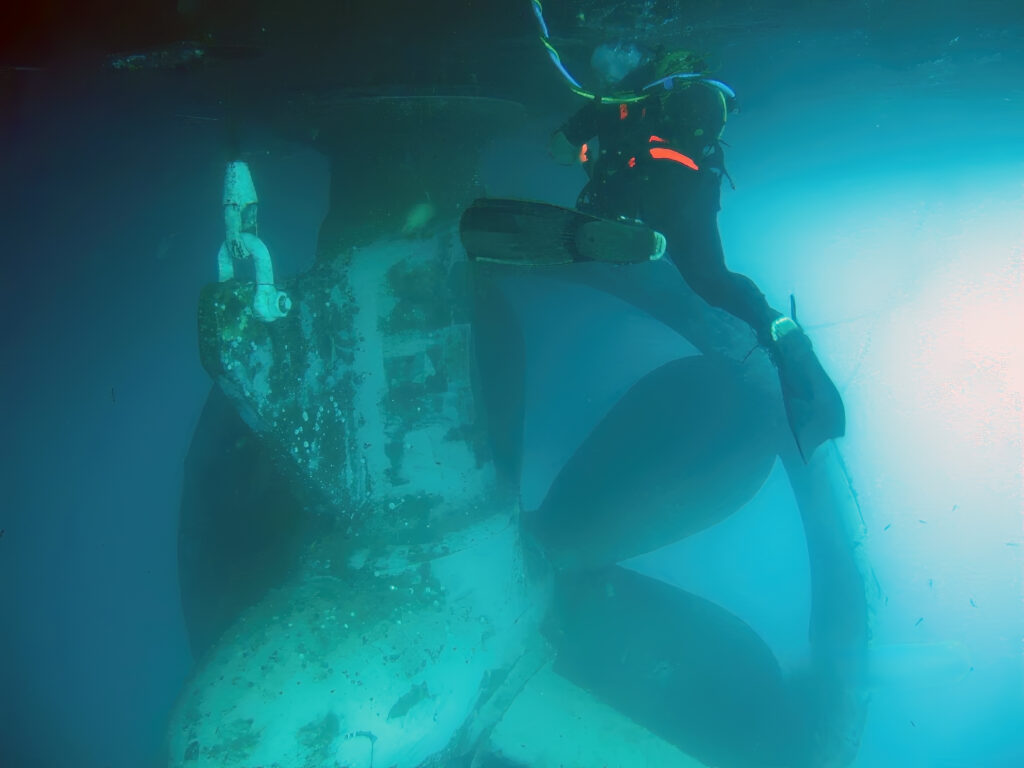
The removal of the thruster began with the lowering of three winch wires through the designated tubes. Next, each wire was secured to one of the padeyes on the azimuth thruster unit. This allowed the unit to be lowered steadily after it had been disconnected from the engine room. During this part of the job the divers were in constant communication with the surface operator to ensure that the thruster was lowered perfectly straight. The unit was then connected to the main crane’s slings and brought out from underneath the platform. Next it was disconnected from the winch wires, lifted to the surface, and brought onboard the vessel where it was overhauled by the manufacturer’s technician.
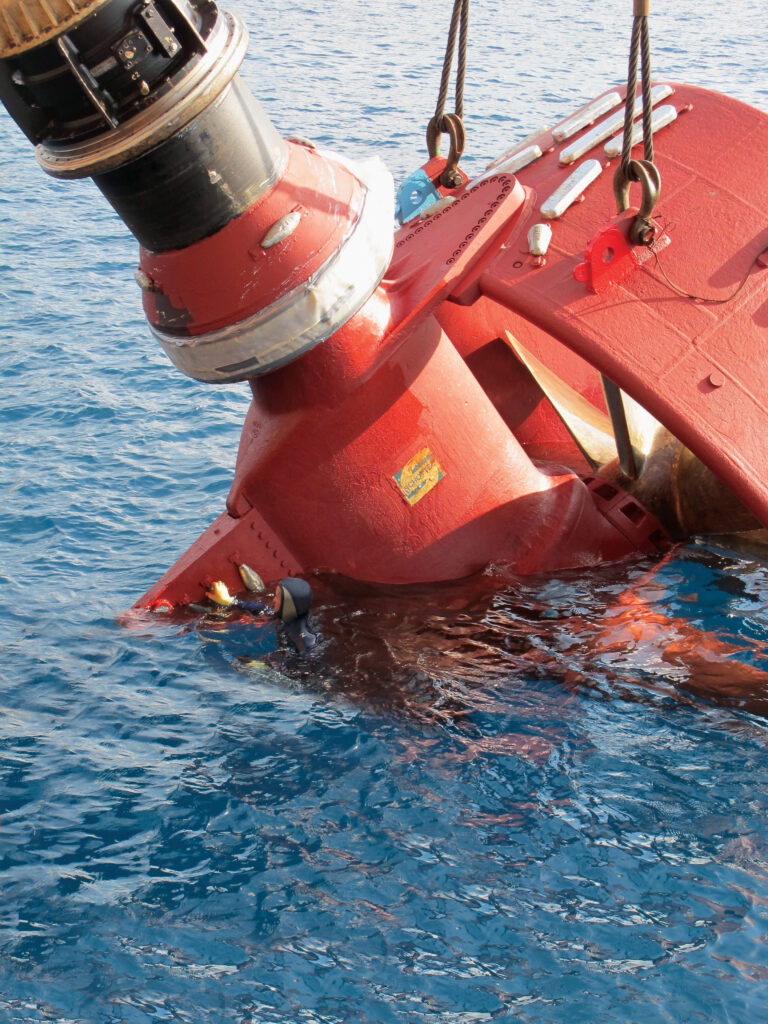
After the repair, the azimuth thruster was reinstalled following the reverse procedure. Meanwhile the cracks in the propeller blades of one of the other thrusters were ground out.
Our teams had performed maintenance and repair work for this customer before. Familiar with our procedures, he asked us to send an experienced and fully certified diver/technician team to carry out a detailed, high-quality underwater inspection and azimuth thruster removal. According to the customer’s Lifting Fleet Manager, the, “…work went very well. The team and equipment were readily available for the task and the operation was carried out in a safe, professional and time-efficient manner, which is not less than what we have grown to expect from Hydrex.”
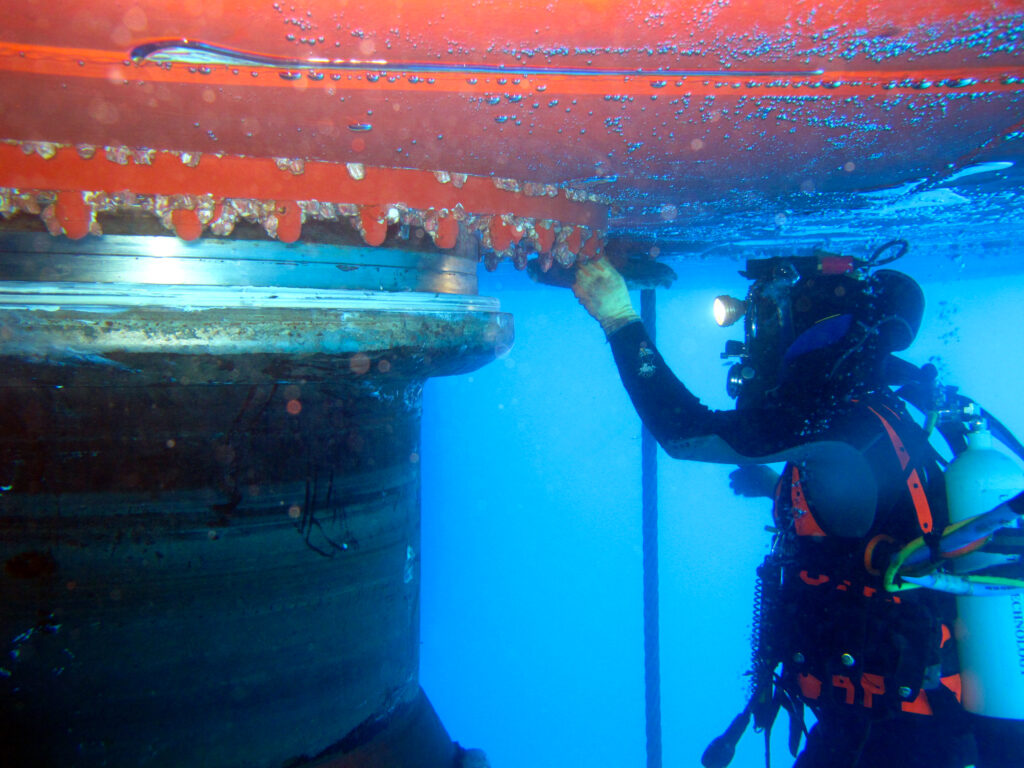
Hydrex enables OEM to access bow thruster out of drydock
When a 162-meter pipe laying vessel suffered an oil leak in 2015, going to drydock for bow thruster repairs seemed the only option. The owner contacted us to see if we could develop an underwater solution that would allow the OEM specialists to access the thruster tunnel while the vessel was still afloat. This would enable the vessel to stay on project.
One of our technicians met with the owner and representatives of the OEM in Mobile, Alabama, to discuss the repair plan devised by our technical department. This proposal included the installation of two open-top cofferdams to close off the thruster tunnel. The OEM specialists could then freely gain access to the bow thruster to examine the unit and make the necessary repairs.

The cofferdams were designed by our in-house R&D department to fit the rounded shape of the ship’s hull. They were built at a local workshop in Mobile. The construction started almost immediately after the operation was approved and the design was finished, to make sure the cofferdams would be ready as soon as the vessel arrived in Mobile.
The cofferdams were positioned and secured with rigging points. All water was then removed from the thruster tunnel to create a dry environment inside the tunnel. The required inspection and repair work could now be performed in conditions similar to those in drydock. Next our technicians removed the tunnel grid to gain access to the bow thruster unit. The oil was then drained from the thruster.
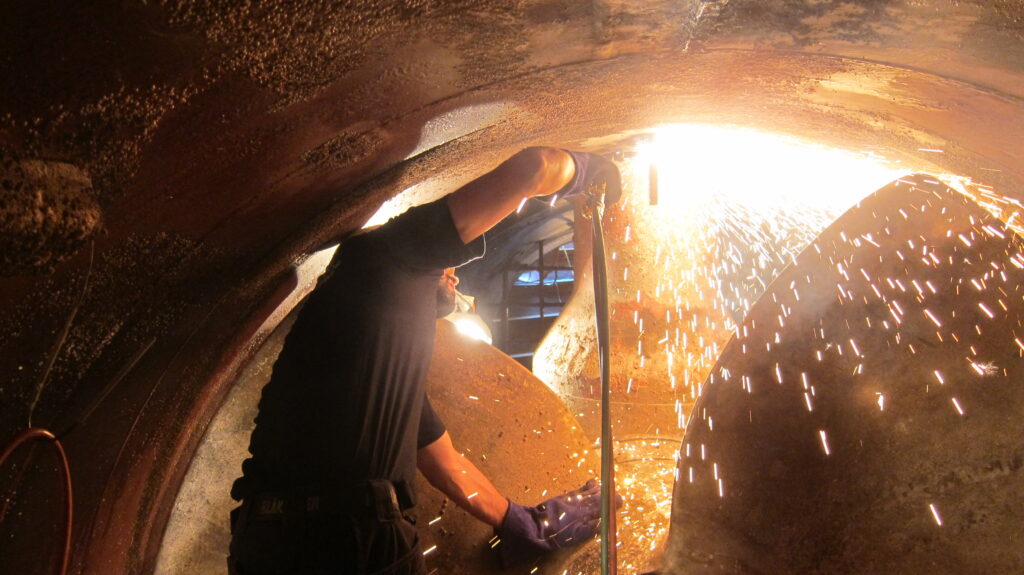
The OEM’s specialists entered the tunnel and examined the bow thruster unit. They decided that the seals needed to be replaced. This specific type of seal assembly required the liner to be pulled out of the assembly in its entirety to work on the seals. To do this, the thruster’s propeller first needed to be removed. Our technicians therefore installed two anchor points in the tunnel to secure the propeller during its removal.
The liner was pulled out of the unit in one piece including the rope guard and the three seals. The rope guard and the seals were then removed from the liner and the seals were replaced. Next the liner and rope guard were repositioned in the assembly and the propeller was reinstalled. Pressure and leakage tests confirmed that the replacement was successful.

Conclusion
The operation required Hydrex to think and handle fast to allow the owner to keep his ship on project. The schedule of the pipe laying vessel offered only a window of two weeks to develop an underwater solution and two further weeks to carry out the operation, including the building of both cofferdams.
The limited time frame available, combined with the extra requirements of the job, are something we know how to deal with. We have fast response centers at our offices which were designed for a swift mobilization to anywhere in the world. We also have 50 years of experience with handling these kinds of situations, which allowed us to come up with the best possible solution that would keep the vessel afloat.
If ever you need assistance with the underwater part of your vessel, give us a call. We can then tell you if the repair is feasible and start working on its handling.
+32 3 213 53 00
hydrex@hydrex.be
Click on the images below for more case studies.

Underwater repair of leaking seal assembly in Trinidad

Underwater bow thruster removal and reinstallation in Australia
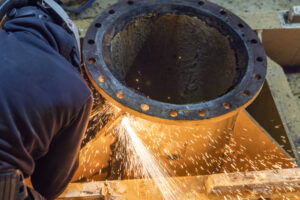
Scrubber overboard pipe repairs in Belgium and the Netherlands

Insert installation in Uruguay prevents loss of contract

Double stern tube seal repair on second vessel in Tasmania confirms customer’s trust
